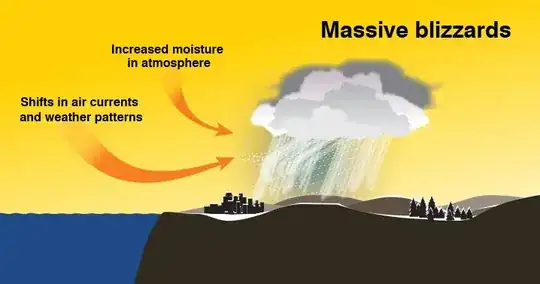The question posed in here "Is it true that a warming planet causes colder temperatures?" is a non-sequitur, following as it does a discussion of changes in patterns of precipitation (in this case snow), rather than temperature.
The article referenced is clearly discussing changes in extreme weather (short term) resulting from climate change (in this case affecting the jetstream). These sot or changes (increases) in extreme weather are indeed discussed in the IPCC reports. See e.g. chapter 11 of the IPCC AR4 WG1 report.
Extremes: There has been a large increase in the available analyses of
changes in extremes. This allows for a more comprehensive assessment
for most regions. The general findings are in line with the assessment
made in TAR and now have a higher level of confidence derived from
multiple sources of information. The most notable improvements in
confidence relate to the regional statements concerning heat waves,
heavy precipitation and droughts. Despite these advances, specific
analyses of models are not available for some regions, which is
reflected in the robust statements on extremes. In particular,
projections concerning extreme events in the tropics remain uncertain.
The difficulty in projecting the distribution of tropical cyclones
adds to this uncertainty. Changes in extra-tropical cyclones are
dependent on details of regional atmospheric circulation response,
some of which remain uncertain.
Compare this with straw man "one side claims all data and predictions are perfectly without fault" (c.f. comment by the OP above). Note that even here in the summary, the IPCC are being very careful to state defficiencies in the modelling work available and the uncertainties. I strongly recommend people obtain a copy of the IPCC report and read that, rather than climate skeptic blogs.
As to polar vortex, the models do predict there will be changes in its behaviour as a result of climate change:
Interannual variability over North America is connected to two
large-scale oscillation patterns (see Chapter 3), ENSO and the NAO/AO.
The MMD model projections indicate an intensification of the polar vortex and many models project a decrease in the arctic surface
pressure, which contributes to an increase in the AO/NAO index; the
uncertainty is large, however, due to the diverse responses of AOGCMs
in simulating the Aleutian Low (Chapter 10). The MMD model projections
indicate a shift towards mean El-Niño like conditions, with the
eastern Pacific warming more than the western Pacific; there is a wide
range of behaviour among the current models, with no clear indication
of possible changes in the amplitude or period of El Niño (Chapter
10).
Again, unlike the climate change dissenters' caricature of the debate, note the clear statement of the uncertainties.
From the most recent AR5 WGI report
Anthropogenic climate change may also bring systematic cold-season
precipitation changes. As with previous models, CMIP5 projections
generally agree in projecting a winter precipitation increase over the
northern half of NA (Figure 14.18 and AI.19). This is associated with
increased atmospheric moisture, increased moisture convergence, and a
poleward shift in ETC activity (Section 14.6.2 and Table 14.3). The
change is consistent with CMIP3 model projections of positive NAO
trends (Table 14.3; Hori et al., 2007; Karpechko, 2010; Zhu and Wang,
2010). Winter precipitation increases extend southward into the USA
(northern portions of SREX regions 3 to 5; Neelin et al., 2013) but
with decreasing strength relative to natural variability. This
behaviour is qualitatively reproduced in higher resolution simulations
(Figure
14.18).
